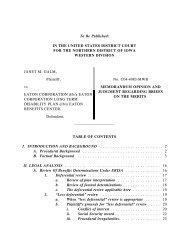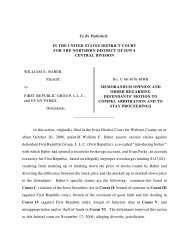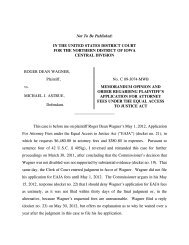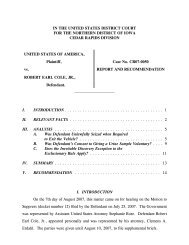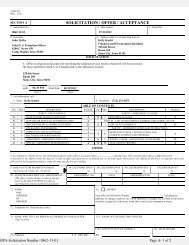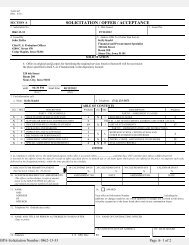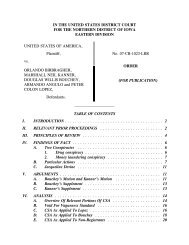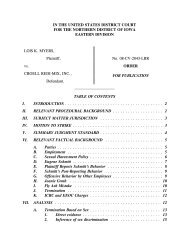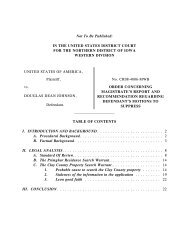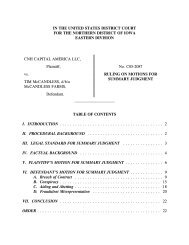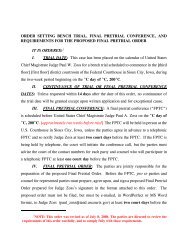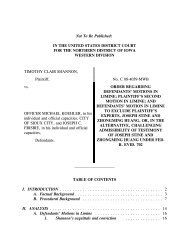Arnzen v. Palmer - Northern District of Iowa
Arnzen v. Palmer - Northern District of Iowa
Arnzen v. Palmer - Northern District of Iowa
You also want an ePaper? Increase the reach of your titles
YUMPU automatically turns print PDFs into web optimized ePapers that Google loves.
Irreparable Harm to the Plaintiff<br />
“Likelihood <strong>of</strong> success” is “‘meaningless in isolation . . . [and] must be examined<br />
in the context <strong>of</strong> the relative injuries to the parties and the public.’” Roudachevski, 648<br />
F.3d at 706 (quoting Gen. Motors Corp. v. Harry Brown’s L.L.C., 563 F.3d 312, 319 (8th<br />
Cir. 2009)); accord Winter, 555 U.S. at 23-24 (there is no need to reach the “likelihood<br />
<strong>of</strong> success” factor, if the balance <strong>of</strong> interests weighs against the injunction). The court<br />
must still consider and balance the other Dataphase/Winter factors to decide whether to<br />
issue a preliminary injunction. Therefore, the court examines the plaintiff’s allegations <strong>of</strong><br />
“irreparable harm.” See Winter, 555 U.S. at 20; Roudachevski, 648 F.3d at 705 (citing<br />
Dataphase, 640 F.2d at 114).<br />
The movant must show that “he is likely to suffer irreparable harm in the absence<br />
<strong>of</strong> preliminary relief.” Winter, 555 U.S. at 20. In Winter, the Supreme Court clarified<br />
that, even where a plaintiff demonstrates a strong likelihood <strong>of</strong> prevailing on the merits,<br />
the plaintiff must do more than show a “possibility” <strong>of</strong> irreparable harm; rather, the proper<br />
standard “requires plaintiffs seeking preliminary relief to demonstrate that irreparable<br />
injury is likely in the absence <strong>of</strong> an injunction.” Id. at 22 (rejecting as “too lenient” the<br />
“possibility” <strong>of</strong> irreparable harm standard used by the Ninth Circuit Court <strong>of</strong> Appeals and<br />
the district court in the case below). “‘Irreparable harm occurs when a party has no<br />
adequate remedy at law, typically because its injuries cannot be fully compensated through<br />
an award <strong>of</strong> damages.’” Rogers Group, Inc. v. City <strong>of</strong> Fayetteville, Ark., 629 F.3d 784,<br />
789 (8th Cir. 2010) (quoting Gen. Motors Corp., 563 F.3d at 319). “To succeed in<br />
demonstrating a threat <strong>of</strong> irreparable harm, ‘a party must show that the harm is certain and<br />
great and <strong>of</strong> such imminence that there is a clear and present need for equitable relief.’”<br />
Roudachevski, 648 F.3d at 706 (quoting <strong>Iowa</strong> Utils. Bd. v. Fed. Commc’ns Comm’n, 109<br />
F.3d 418, 425 (8th Cir. 1996)).<br />
9



